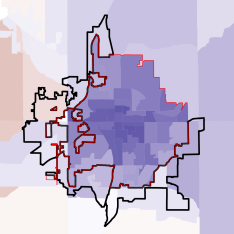Acute political angle on Bloomington annexation lawsuit

In 2017, the city of Bloomington filed a lawsuit against Gov. Eric Holcomb in connection with the city’s planned annexations.

The lawsuit was precipitated by the General Assembly’s action in 2017 to build into the budget bill a change to annexation law—which effectively singled out Bloomington of all Hoosier cities—that paused any annexation plans for five years. Bloomington contends the General Assembly violated two clauses of the state’s constitution: One limiting bills to single topics and another prohibiting special legislation.
After some technical skirmishing about whether Holcomb is an appropriate defendant (he is, according to the judge) and whether some video of the General Assembly can be admitted as evidence (it can’t be, according to the judge), the case has progressed to a significant hearing on Tuesday, March 26.
No ruling is expected that day. The two sides will be giving oral arguments in front of the judge to complement the written arguments and counterarguments they’ve already submitted to the court.
The Bloomington mayor’s race in the Democratic Party primary has featured contrasting views from the two candidates on the lawsuit.
At a recent forum hosted by Democracy for Monroe County, challenger Amanda Barge was eager to end the legal wrangling, saying she wanted instead to collaborate with residents and business owners in areas around Bloomington to build consensus on annexation. Incumbent John Hamilton appeared keen to pursue the lawsuit through every possible appeal, if necessary.
Gov. Holcomb is a Republican. A better-than-two-thirds majority is held by Republicans in the General Assembly. In contrast, all of Bloomington’s city councilmembers are Democrats, as are the other two elected city officials, mayor and clerk. In that light, it’s not surprising that the General Assembly’s action to suspend Bloomington’s in-progress annexations has been analyzed by some as motivated by partisan politics.
Whatever the merits of that analysis, it’s worth considering: What are the political leanings of residents who live in areas proposed to be annexed?
Maps of Monroe County shaded by precinct for recent election results give some insight.
Colorful Maps
The race for U.S. Senate in November 2018—between Democrat Joe Donnelly and Republican Mike Braun—was won by Braun. In Monroe County, though, Donnelly tallied a majority of votes. But the results inside the county weren’t uniform.
Inside Bloomington, Donnelly carried every precinct, but not by the same margin. Donnelly did better in precincts closer to the city center than those toward Bloomington’s outer boundary. Outside the city, the trend continues: Support diminishes for Donnelly as the distance from the city center increases. The trend is especially robust on the western side of the county.
What about the specific areas that Bloomington proposed for annexation? On the maps below, the red lines represent Bloomington’s existing municipal boundary, and heavy black lines represent boundaries of areas proposed to be annexed. Despite diminished support compared to the city core, Donnelly still carried most of the area proposed to be annexed. The area in Richland Township, northwest of the city, is the exception.

The public question on the ballot in November 2018 asked voters if they wanted to add a constitutional amendment requiring the state to have a balanced budget. It received a majority of votes statewide, including in Monroe County, even inside the city of Bloomington.
But the result inside Monroe County wasn’t uniform. It followed a pattern similar to the Donnelly-Braun outcome. Precincts where a majority of voters opposed the amendment are closer to the city center. Opposition dwindles as the distance from the city center grows.
The balanced-budget amendment won every precinct outside the city, including all the areas proposed to be annexed by Bloomington in 2017.





Comments ()